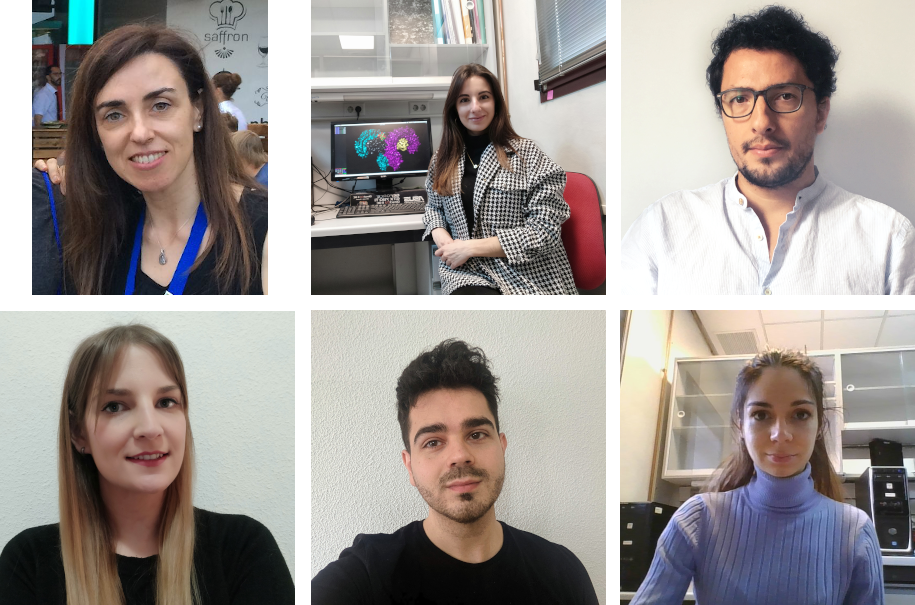Responsable/s del laboratorio
intro

The research interests of the CCB group lie at the interface between Chemistry and Biology, by means of molecular modeling and computational chemistry applied to the understanding of ligand-receptor interactions and molecular recognition processes relevant for drug design. We combine these investigations with structural studies, synthesis of compounds, and biological studies in close collaboration with international groups, within a multidisciplinary and integrative approach.
We are focused on the study of the molecular recognition processes involving Pattern Recognition Receptors (PRRs), such as Toll-like receptors (main actors in innate immunity), and lectins (carbohydrate-binding proteins with important roles in infection, inflammation, and tumor progression). Our global goal is to understand the molecular details of ligand recognition as a source of new compounds able to modulate the target behaviour with possible therapeutic applications.
Miembros
| Sonsoles Martin Santamaria |
| Juan Guzman Caldentey |
| Marina Minguez Toral |
| Laura Garcia Robles |
| Olmo Martin Camara |
| Andrea Baldi |
| Alvaro Arrayas Ruiz |
| Gema Fernandez Vasco |
| Sergio Cubillas Gonzalez |
| STANISLAV DUBROVIN |
| Tania Gelpe Amor |

Publicaciones seleccionadas
Matamoros-Recio A, Franco-Gonzalez JF, Forgione RE, Torres-Mozas A, Silipo A, Martín-Santamaría S.* [2021]. Understanding the Antibacterial Resistance: Computational Explorations in Bacterial Membranes. ACS Omega, 6, 9, 6041–6054. DOI: 10.1021/acsomega.0c05590
Medve L, Achilli S, Guzman-Caldentey J, Thépaut M, Senaldi L, Le Roy A, Sattin S, Ebel C, Vivès C, Martin-Santamaria S,* Bernardi A,* Fieschi F.* [2019]. Enhancing Potency and Selectivity of a DC-SIGN Glycomimetic Ligand by Fragment-Based Design: Structural Basis. Chem. A Eur. J. 2019, 25, 14659-14668. DOI: 10.1002/chem.201903391
Carpintero-Fernandez P, Varela-Eirin M, Lacetera A, Gago-Fuentes R, Fonseca E, Martin-Santamaria S,* Mayan MD.* [2020]. New Therapeutic Strategies for Osteoarthritis by Targeting Sialic Acid Receptors. Biomolecules. 10(4), 637. DOI: 10.3390/biom10040637
Di Carluccio C, Crisman E, Manabe Y, Forgione RE, Lacetera A, Amato J, Pagano B, Randazzo A, Zampella A, Lanzetta R, Fukase K, Molinaro A, Crocker PR, Martín-Santamaría S,* Marchetti R,* Silipo A.* [2020]. Characterisation of the Dynamic Interactions between Complex N-Glycans and Human CD22. ChemBioChem. 2020, 21, 129-140. DOI: 10.1002/cbic.201900295
Gimeno A, Delgado S, Valverde P, Bertuzzi S, Berbís MA, Echavarren J, Lacetera A, Martín-Santamaría S, Surolia A, Cañada FJ, Jiménez-Barbero J, Ardá A. [2019]. Minimizing the Entropy Penalty for Ligand Binding: Lessons from the Molecular Recognition of the Histo Blood-Group Antigens by Human Galectin-3. Angew. Chem. Int. Ed. Engl. 2019, 58, 7268-7272. DOI: 10.1002/anie.201900723
Computational tools for Chemical Biology. [2018]. Editor: S. Martín-Santamaría. London. Chemical Biology series. Royal Society of Chemistry. ISBN: 978-1-78262-700-5. DOI: 10.1039/9781788010139
Entova S, Billod JM, Swiecicki JM, Martín-Santamaría S, Imperiali B. [2018]. Insights into the key determinants of membrane protein topology enable the identification of new monotopic folds. Elife. 2018, 7. pii: e40889. DOI: 10.7554/eLife.40889
Lembo-Fazio L, Billod JM, Di Lorenzo F, Paciello I, Pallach M, Vaz-Francisco S, Holgado A, Beyaert R, Fresno M, Shimoyama A, Lanzetta R, Fukase K, Gully D, Giraud E, Martín-Santamaría S,* Bernardini ML,* Silipo A.* [2018]. Bradyrhizobium Lipid A: Immunological Properties and Molecular Basis of Its Binding to the Myeloid Differentiation Protein-2/Toll-Like Receptor 4 Complex. Front. Immunol. 2018, 14, 9:1888. DOI: 10.3389/fimmu.2018.01888
Ghirardello M, de Las Rivas M, Lacetera A, Delso I, Lira-Navarrete E, Tejero T, Martín-Santamaría S,* Hurtado-Guerrero R,* Merino P.* [2016]. Glycomimetics Targeting Glycosyltransferases: Synthetic, Computational and Structural Studies of Less-Polar Conjugates. Chem. A. Eur. J. 22, 7215-24.
Sestito SE, Facchini FA, Morbioli I, Billod JM, Martin-Santamaria S, Casnati A, Sansone F, Peri F. [2017]. Amphiphilic Guanidinocalixarenes Inhibit Lipopolysaccharide (LPS)- and Lectin-Stimulated Toll-like Receptor 4 (TLR4) Signaling. J. Med. Chem. 2017, 60, 4882–4892. Issue cover.
Fondos
Current funding
MINECO. CTQ2017-88353-R. Computational studies of innate immunity molecular mechanisms: Toll-like receptors. 2018-2021
Comunidad de Madrid. S2010/BMD-2316. Biología y fisiopatología del sistema del complemento. 2018-2021
CSIC-COV19-082 & Fondo SUPERA “BlockAce”. Multidisciplinary approach to blocking SARS-CoV-2 entry through antivirals and Decoy-ACE2 fragments. 2020-21.
PRACE COVID-19-26. Identification of inhibitors of SARS-CoV-2 S protein. 2020-21.
PRACE-ICEI. Call#4. Molecular mechanisms of innate immunity and bacterial resistance. 2021
Past funding
Red Española de Supercomputación (RES). QSB-2020-2-0017. Computational simulations of liposomes as models for the study of AMR. 2020.
MINECO. CTQ2014-57141-R. Molecular Pattern Recognition Receptors: Computational Chemistry Insights for Drug Design and Innate Immunity Modulation.
Marie Skłodowska-Curie Actions. Innovative Training Networks. H2020-MSCA-ITN-2014. “TOLLerant” Toll-Like Receptor 4 activation and function in diseases: an integrated chemical-biology approach. www.tollerant.eu
MINECO. CTQ2011-22724. Molecular recognition processes of therapeutic targets involved in immunity and bacterial infection. Approaches from Computational Chemistry.
Marie Curie Initial Training Networks FP7-PEOPLE-2012-ITN 317297. “GLYCOPHARM. The Sugar Code: from (bio)chemical concept to clinics”. www.glycopharm.eu
COST Action BM1003. “Microbial cell Surface determinants of virulence as targets for new therapeutics in cystic fibrosis”. www.cost-bm1003.info/

